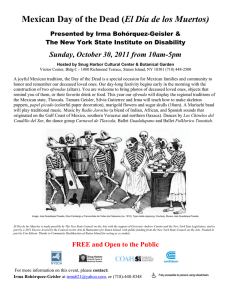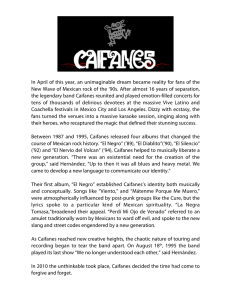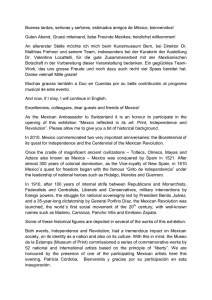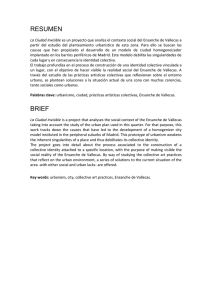Mexican Community Theatre in a Midwestern City
Anuncio
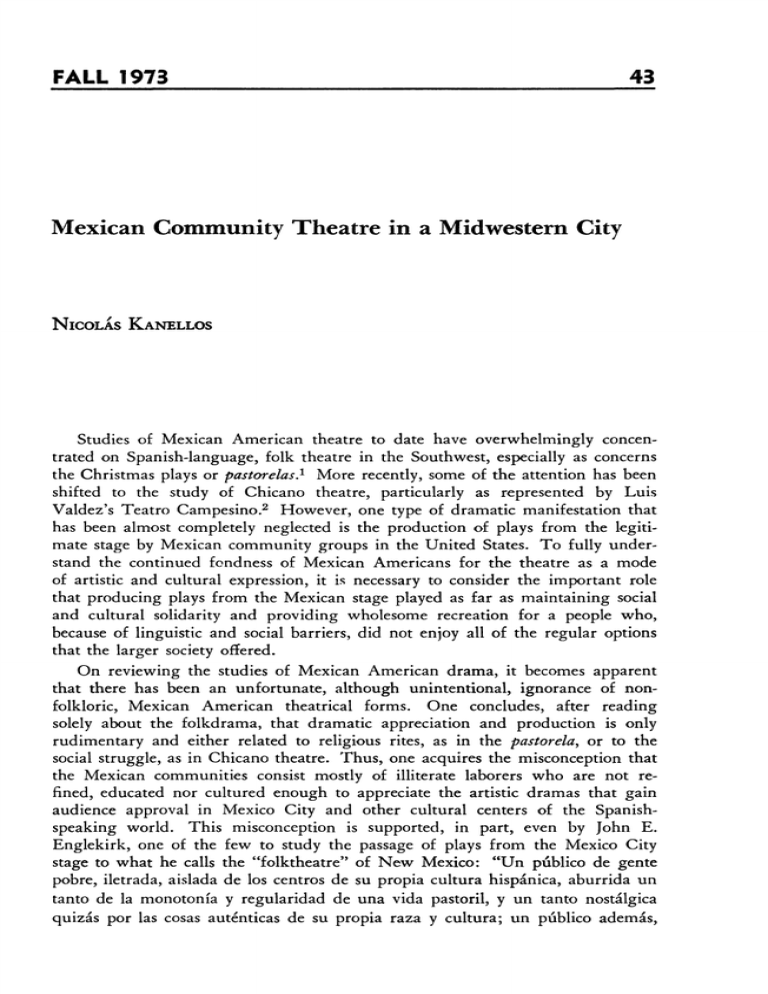
FALL 1973 43 Mexican Community Theatre in a Midwestern City NICOLÁS KANELLOS Studies of Mexican American theatre to date have overwhelmingly concentrated on Spanish-language, folk theatre in the Southwest, especially as concerns the Christmas plays or pastorelas.1 More recently, some of the attention has been shifted to the study of Chicano theatre, particularly as represented by Luis Valdez's Teatro Campesino. 2 However, one type of dramatic manifestation that has been almost completely neglected is the production of plays from the legitimate stage by Mexican community groups in the United States. To fully understand the continued fondness of Mexican Americans for the theatre as a mode of artistic and cultural expression, it is necessary to consider the important role that producing plays from the Mexican stage played as far as maintaining social and cultural solidarity and providing wholesome recreation for a people who, because of linguistic and social barriers, did not enjoy all of the regular options that the larger society ofTered. On reviewing the studies of Mexican American drama, it becomes apparent that there has been an unfortunate, although unintentional, ignorance of nonfolkloric, Mexican American theatrical forms. One concludes, after reading solely about the folkdrama, that dramatic appreciation and production is only rudimentary and either related to religious rites, as in the pastorela, or to the social struggle, as in Chicano theatre. Thus, one acquires the misconception that the Mexican communities consist mostly of illiterate laborers who are not refined, educated nor cultured enough to appreciate the artistic dramas that gain audience approval in Mexico City and other cultural centers of the Spanishspeaking world. This misconception is supported, in part, even by John E. Englekirk, one of the few to study the passage of plays from the Mexico City stage to what he calls the "folktheatre" of New Mexico: "Un público de gente pobre, iletrada, aislada de los centros de su propia cultura hispánica, aburrida un tanto de la monotonía y regularidad de una vida pastoril, y un tanto nostálgica quizás por las cosas auténticas de su propia raza y cultura; un público además, 44 LATIN AMERICAN THEATRE REVIEW que no se da cuenta de que los gustos literarios y estéticos cambian con los años." 3 He further asserts that the New Mexican public was not interested in the authorship of the plays4 and that so tenuous was the public's fondness for live theatre that these "folkloric" performances met their demise with the advent of the silent screen.5 If the picture drawn by Englekirk were ever true for the Mexican Americans of New Mexico, it is not analagous to the theatrical activity which occurred during the first three decades of the twentieth century in other centers of Mexican population in the United States where similar plays were produced. In these centers it seems that the public's level of education and appreciation of theatre was somewhat higher than that of the New Mexicans described by Englekirk. It is the purpose of the present study to affirm, based on evidence to be found in newspapers from the twenties and from interviews with former participants in theatrical productions, that a lively interest in the dramatic arts was maintained by a cultured and educated Mexican community, at least in the Calumet region of Indiana. This study hopes to introduce the reader to the theatrical activities of the Mexican community of East Chicago, Indiana, during the 1920's. Dating from the second decade of the twentieth century, the urban, industrial complex of East Chicago, Indiana, attracted large-scale immigration from Mexico and Mexican American migration from the Southwest. In particular, the economic security that derived from the fast-growing steel industry along Lake Michigan was a prime motivation for the settlement of Mexicans in the area. Furthermore, the economic and social turmoil produced by the Mexican Revolution, in combination with the shortage of manpower in the United States during World War I, among other factors, explains the influx of Mexicans to East Chicago. By 1930, almost 10% of East Chicago was Mexican, with over a 30% concentration of Mexicans in its Indiana Harbor section.6 As was the case in most of the cities with a large Mexican population, the Mexican colony consisted of rural and semi-rural groups from the Southwest, former braceros from Mexico, and political refugees from the Mexican Revolution.7 The latter, who soon became the leaders of the Mexican colonies, set about preserving the Mexican culture in exile.8 To be sure, the majority of the population consisted of laborers, many of whom came from a rural setting, but intellectuals and professional people also made up a considerable portion of the community. Many of the intellectuals were political and religious refugees from Mexico who, underemployed in the United States as manual laborers because of linguistic and social barriers, sought to preserve their cultural and religious identity in their new home. They also desired to approximate their former middle class and aristocratic lives, if not in the economic sense, at least in the cultural, by sponsoring and participating in many educational, religious, and social activities. It is this sector of the community, through its various religious and mutualist societies, that created and sponsored theatre productions for the Mexican community as a whole. Of the three or four societies sponsoring plays in East Chicago during the twenties, the most active seems to have been the Círculo de Obreros Católicos "San José" with its Cuadro Dramático. The Círculo de Obreros Católicos "San José" was founded on April 12, 1925, for the express purposes of (1) raising FALL 1973 45 funds for the construction of a church, (2) promoting the welfare of fellow Mexicans and working for the education of their children, (3) raising funds for a library, and (4) providing wholesome forms of recreation for the members. 9 In accordance with these goals, the Cuadro Dramático was created to provide "wholesome recreation" and raise funds for the construction of Our Lady of Guadalupe Church. According to the weekly newspaper and official organ of the Círculo de Obreros, El amigo del hogar, published from 1925 to 1930,10 nine plays were presented by the Cuadro Dramático from March, 1927, until May, 1928.11 It is most likely that the Cuadro Dramático fulfilled more the recreational than the financial goals of the Círculo since after the $35.00 to $50.00 for rental of Auditorium Hall, and the costs of refreshments, programs, transportation, musicians, and scenery were paid for, the net profits usually totalled only from $12.00 to $60.00 per program. The tickets were usually priced as follows: reserved seats at $.75, general admission at $.50 and amphitheatre at $.40. Community involvement in the productions was extensive and included participation as actors in casts often in excess of twenty characters, prompters, scenographers, musicians, ushers, etc. Moreover, judging from the records of ticket sales, the productions drew audiences of over two hundred people. Tickets would not only be sold at the door, but also at selected shops and gathering places in the community. It is not safe to assume that the presentations were only of an amateur nature. Rather, it must be emphasized that along with the aficionados, former professionals from the Mexico City stage took part. Such was the case of J. Jesús Cabrera, who directed all of the plays of the Cuadro Dramático and who brought the scripts from Mexico.12 Furthermore, the quality of the productions must have been good, not only because of the professionalism, but also because of the extensive preparation of the plays and the enthusiasm exhibited by both the participants and the community. The following review is an example of the appreciation accorded the plays: Las palmas y lauros más gallardos y el más esplendente triunfo de cuantos el cuadro dramático de aficionades del C. O. C. "San José" ha sabido conquistar fueron alcanzados el sábado antepasado al llevarse a la escena el soberbio drama titulado "EL CONDE DE MONTE-CRISTO" en el que sus actores, con exquisita y afiligranada galanura hicieron derroche de las más brillantes joyas que a fuerza de constancia y denodados esfuerzos han logrado arrancar a las complexidades del arte, haciendo renacer con el calor y sutilezas de su perfecta interpretación las interesantes escenas que han inmortalizado a los personajes que intervinieron en la formación de tan maravillosa obra dando con ello mayores brillos a las regias preseas de su digno director el Sr. J. Jesús Cabrera. Momentos de verdadero deleite y patéticas emociones, fueron disfrutados en aquella noche de arte y elocuente belleza durante los cuales siempre estuvieron palpitantes y cautivos el interés y la expectante atención del culto y galante público que arrobado y complacido hasta lo extremo por ser el admirador de tan arrebatador espectáculo no pudo 46 LATIN AMERICAN THEATRE REVIEW menos que premiar entusiasta y frenético con estruendosas ovaciones la magnificencia de nuestros aficionados. Con magistral atractivo y encantadora singularidad viéronse descollar en la interpretación artística del drama a las simpáticas Señoritas Ma. Encarnación Rea, Ma. Perpetua Pacheco, María L. Peña y Rafaelita Macias que por sus facultades, dedicación y voluntad han sido por esta vez las estrellas de primera magnitud que derrocharan a manos llenas las divinidades del arte arrebatando a la selecta concurrencia hasta el ambiente mágico de lo inefable y de lo ideal. No menos encomiable y digna de elogio estuvo la actitud de los galantes y abnegados caballeros dando por tanto al Sr. Cabrera, Director y alma de nuestro cuadro, los más expresivos parabienes felicitándola cordial y sinceramente por el justo galardón de su bien desempeñada labor. 13 While the New Mexican plays that Englekirk identified were, for the most part, saínetes whose authorship was unidentified, in most cases the Cuadro's plays were full-length, and their authors were clearly identified on the playbills and programs. Moreover, the only saínete (El que nace para ochavo) by the Cuadro Dramático was presented on the same bill with a full length play, Jacinto Benavente's El nido ajeno. In fact, the Cuadro Dramático even accomplished the tremendous feat of producing the prologue and five acts of the Spanish play, El juez de su sangre by Eduardo Vidal y Valencia and José Roca y Roca. The plays in their chronological order of presentation were: El nido ajeno, by Jacinto Benavente, and El que nace para ochavo (March 13, 1927); Hermán o La vuelta del Cruzado, by Fernando Calderón (April 2, 1927); El Conde de Monte-Cristo (April 30, 1927); El caudal de los hijos;14 La mujer X, by Bisson (November 19, 1927); El juez de su sangre, by Eduardo Vidal y Valencia and José Roca y Roca (February 19, 1928); Los pobres de Madrid, by Manuel Ortiz de Pinedo (February 4, 1928); and Santa Inés, a Silesian play (May, 1928). There is news of other plays directed by J. Jesús Cabrera but performed by groups other than the Cuadro Dramático: El herrero o Felipe Derblay, by Ohnet (January, 1926); La muerte civil, by Giacometti (March, 1927); Para mentir las mujeres and Levantar muertos (October, 1928); and La nuza (August, 1929). It should be noted that most of these plays were still being performed in Mexico City. 15 It is, therefore, possible that there was an awareness of theatrical activities in the Mexican capital. Unlike the theatrical manifestations recorded by Englekirk in New Mexico, attendance at the performances was not hampered by competition from the motion pictures which, since February, 1926,16 were shown with subtitles in Spanish. To the contrary, the public supported and appreciated both the motion pictures and live drama, as attested to by the pride that the Mexican community took in having its own cinema house, besides supporting the Cuadro Dramático. 17 What eventually put an end to the Cuadro Dramático's activities, as well as the activities of other groups, is the Depression and the mass repatriation of Mexicans from the area. Immediately following the advent of the economic cataclysm, J. Jesús Cabrera returned to Mexico where he later died. Not until the late forties and early fifties is there any news of a regeneration of dramatic FALL 1973 47 productions by the Mexican community in East Chicago. Many of these again spring up in association with Our Lady of Guadalupe Church, although with a younger generation of participants. Today, the heirs to this tradition are the young adults who take part in Chicano theatre in the area. In at least one case, the daughter of an actress of the earlier plays is an actress in the Gary-East Chicago based Teatro Desengaño del Pueblo. A further note before closing, the Cuadro Dramático of the Círculo de Obreros Católicos "San José" was, by no means, the only Mexican theatrical group in the area. There are announcements and reviews in El amigo del hogar of plays produced by Cruz Azul Mexicana, Cuadro de Aficionados de Gary, the Arcos family, Sociedad Fraternal de Chicago, as well as zarzuelas and cuadros de variedades by professional companies on tour. In summary, the Cuadro Dramático of the Círculo de Obreros Católicos "San Jose" attests to the existence of sophisticated forms of theatre in the Mexican American community. The production of plays from the stages of Mexico City served to solidify the Mexican immigrants and migrants into a community with a sense of pride in its cultural and artistic endeavors. The Cuadro Dramático also assisted in the construction of the central and most important institution of the community: Our Lady of Guadalupe Church. Moreover, the Cuadro Dramático, along with the other theatrical groups, represents an important chapter in the continuing love of Mexican Americans for the theatre, a love dating back to the indigenous peoples of Mexico and the Spaniards, which has been expressed in a variety of forms from the pastorela and the matachines to vaudeville and Chicano theatre. Indiana University Northwest (Gary) Notes 1. See: Arthur L. Campa, Spanish Religious Volktheatre in the Spanish Southwest. University of New Mexico Bulletin: Language Series, 5, 1 and 2, 1934; T. M. Pearce, "The New Mexican 'Shepherd's Play,' " Western Folklore, 15 (Jan., 1956), 77-88; Juan Bautista Rael, The Sources and Diffusion of the Mexican Shepherd's Play (Guadalajara, 1965); Stanley L. Robe, "The Relationship of Los Pastores to Other Spanish-American Folk Drama," Western Folklore, 16 (Oct., 1957), 281-287. 2. See: Beth Bagley, "El Teatro Campesino, Interview with Luis Valdéz," Tulane Drama Review, 2 (Summer, 1976), 70-80; Pedro Bravo Elizondo, "El teatro Chicano," Revista Chicano-Riqueña, I, 2 (Otoño, 1973), 36-42; Luis Valdéz, "Notes on Chicano Theatre," Aztlan: An Anthology of Mexican American Literature, eds. Luis Valdéz and Stan Steiner (New York: Vintage Books, 1972), 354-359; Tomás Ybarra-Frausto, "Chicano Theatre: Punto de Partida," Latin American Theatre Review, 4/2 (Spring, 1971), 51-55. 3. John E. Englekirk, "Fernando Calderón en el Teatro Popular Nuevomexicano," Memoria del Segundo Congreso del Instituto Internacional de Literatura Iberoamericana (1941), p. 230. 4. Ibid., p. 229. 5. John E. Englekirk, "Notes on the Repertoire of the New Mexican Spanish Folktheatre," Southern Folklore Quarterly, 4 (Dec, 1940), p. 237. 6. Paul S. Taylor, Mexican Labor in the United States: Chicago and the Calumet Region (Berkeley and Los Angeles: University of California Press, 1932), p. 36. 7. Américo Paredes, "El folklore de los grupos de origen mexicano en los Estados Únicos," Folklore Americano, 14 (1966), p. 154. 8. Ibid. 9. Estatutos del Círculo de Obreros Católicos "San José," (Indiana Harbor, 1925), p. 16. 10. Microfilm copies of El amigo del hogar are possessed by the East Chicago Public Library and Indiana University Northwest. 48 LATIN AMERICAN THEATRE REVIEW 11. The first sixteen issues of El amigo del hogar are missing; thus, there may have been plays produced by the Cuadro Dramático prior to March, 1927. 12. Mrs. Consuelo C. de Figueroa, who acted in many of the Cuadro Dramático's productions, was my informant in this matter. She is also the widow of Francisco M. de Figueroa, editor of El amigo del hogar, and one of the founders of El Círculo de Obreros Católicos "San José." 13. El amigo del hogar, 2, 44 (May 8, 1927), p. 1. 14. El caudal de los hijos was announced on August 13, 1927, but there was no subsequent information about its production in El amigo del hogar. 15. See: Enrique de Olavarria y Ferrari, "Nómina de los teatros capitalinos y de las obras o espectáculos en ellos ofrecidos desde octubre de 1911 hasta el 30 de junio de 1961," Reseña histórica del teatro en México, Vol. V (Mexico: Editorial Porrua, 1961), pp. 33813680. 16. "Apertura del Teatro Juarez," El amigo del hogar, 1, 28 (February 2 1 , 1926), p . 1. 17. A percentage of the cinema's profits was also donated regularly for the construction of Our Lady of Guadalupe Church.

